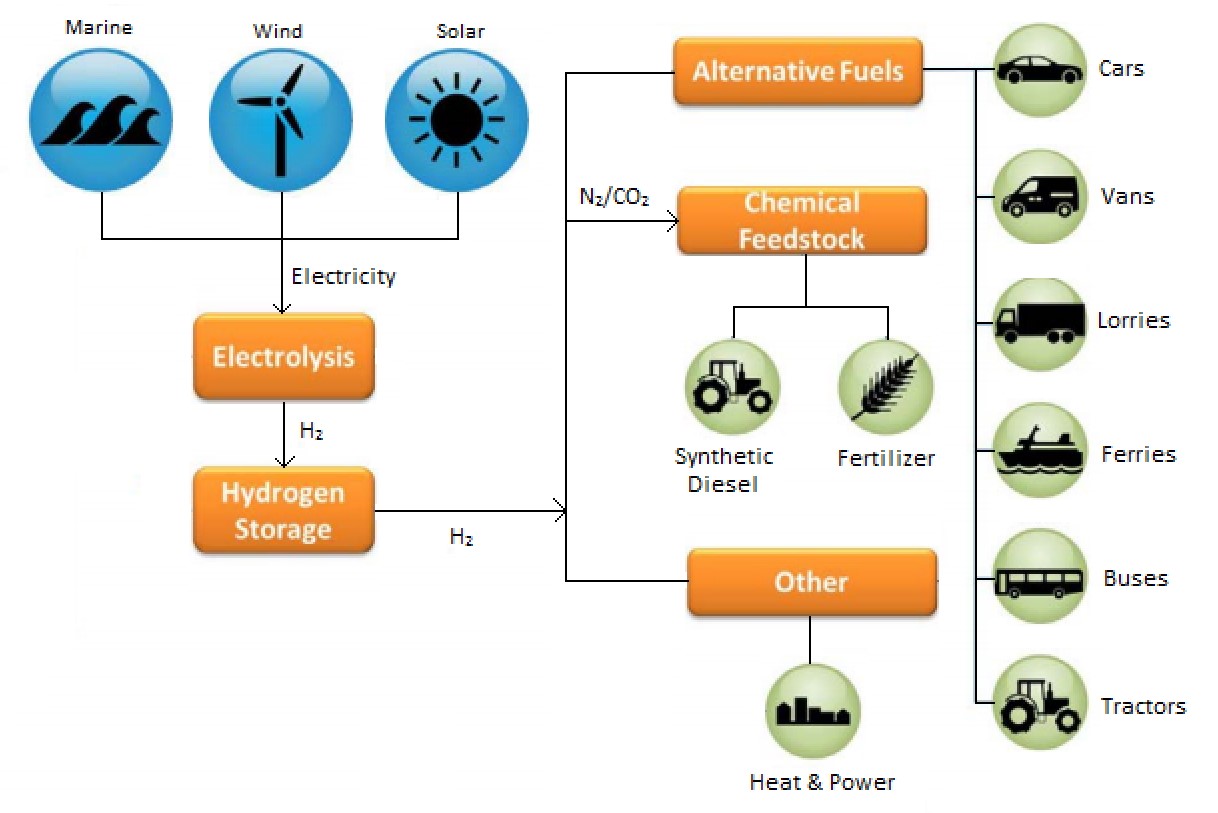
We discussed hydrogen generation techniques in our 2014 guest blog by Matt Stern. Since that time, the world has continued its fascination with this element, and recent developments show some interesting progress.
Intern Karley Hildin provides an update:
One really interesting example is a project taking place in Orkney, an island chain in the Northern Isles of Scotland (Figure 1). Orkney has been leading the way in energy innovation since its first commercial wind turbine was built in 1951. Since then, the islands have accumulated 700 wind and 350 solar generators. Their renewable energy generation has been so successful that it exceeds Orkney’s electricity demand and now they are looking at energy export.
So, what is their solution to an overabundance of electricity? Actual transportable sustainable hydrogen production.

Figure 1. Orkney, Scotland
Surf ‘n’ Turf is an innovative community project in Orkney that uses electricity from its renewable energy sources to create hydrogen gas as fuel.
On Eday, one of the Orkney islands, excess tidal and wind power are collected and the electricity is used to power the 500kW Proton Exchange Membrane (PEM) electrolyzer owned by the European Marine Energy Center (EMEC). The PEM electrolyzer is suitable for this environment because it is able to use variable energy inputs more efficiently than other electrolyzer technologies.
The hydrogen is stored as compressed gas and is then transported via trailer to the island’s harbor. One of Orkney’s inter-island vessels transports the compressed hydrogen to Kirkwall, Scotland. A fuel cell supplied by Arcola Energy uses the hydrogen to provide auxiliary electrical power for ferries tied up at the pier in the Kirkwall Harbor.
A flowchart showing the hydrogen production process, storage, and potential uses in Orkney is shown in Figure 2. In the future, Surf ‘n’ Turf is looking to expand their hydrogen program even further by using it as a fuel on board vessels at sea. For now, they are training crew members to work with alternative fuels safely on dry land.

Figure 2. Hydrogen production, storage, and potential uses in Orkney
It turns out another hydrogen infrastructure is being developed in eastern Canada. Prince Edward Island, Canada’s smallest province just north of Nova Scotia, has developed Canada’s first Wind-Hydrogen Village. The purpose of the Prince Edward Island (PEI) Wind-Hydrogen Village is to use excess wind energy along with hydrogen technologies to offer sustainable energy. Excess electricity produced by wind turbines on the island is being used to power a 300kW uni-polar electrolyzer.
A uni-polar electrolyzer uses alkaline liquids, rather than solid polymer, as its electrolyte. The electrolyzer can produce about 6kg of hydrogen per hour. The hydrogen is then stored as compressed gas in storage tanks that have a total capacity of about 500kg. The hydrogen is then used in the bi-fuel hydrogen/diesel genset to power the village when there is no wind. Future phases of the PEI Wind-Hydrogen Village will include refueling stations for the three full-service hydrogen shuttle buses in Charlottetown, as well as deployment of fuel cell utility vehicles. The final phase will include plans to introduce a hydrogen-powered tour boat for the island.
Hydrogen infrastructure has inherent advantages over static energy storage such as batteries and stored hydro. Most importantly, static energy storage may not solve sustainable fuel issues in the transport sector. Hydrogen may fulfill that role by providing a clean alternative energy source for ships and planes (and rockets). While uncertainties still exist (greenhouse gas effects from hydrogen, storage and transport safety, etc.), the approach taken by these two projects mirror the implementation of prior, major infrastructure changes.
Steamboats did not arrive at once, but, instead, needed particularly attractive applications, such as the Clermont. Containerization was first started in a run from NY to Houston, or through the mountain pass on the White Pass & Yukon Railroad. These small hydrogen projects may not yet be the killer apps, but, like these other projects, they certainly can point the way. We salute the hard work of these communities, and look forward to the challenges and innovations of hydrogen generation that lie ahead.

Karley Hildin graduated from The College of New Jersey in mechanical engineering. Her school projects have involved solar powered boats, and at Martin & Ottaway she has worked on the larger sustainable energy infrastructure space. She is currently working as an Imagineer at Disney.

